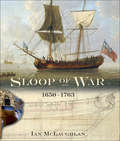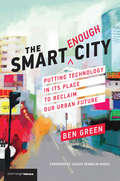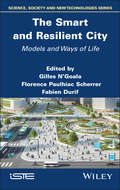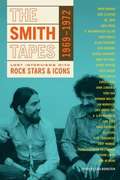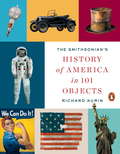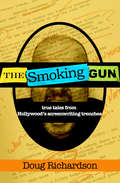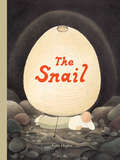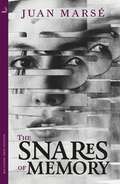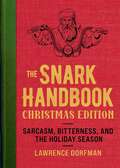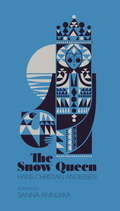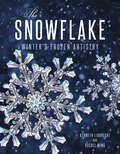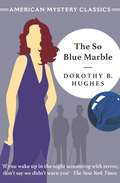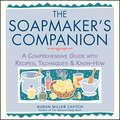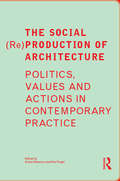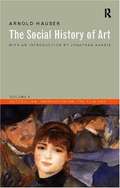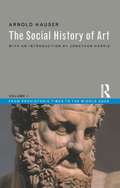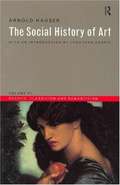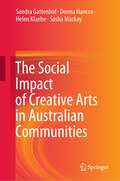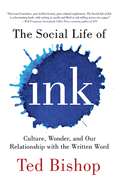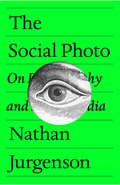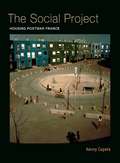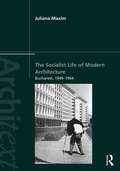- Table View
- List View
The Sloop of War, 1650–1763: 1650-1763
by Ian McLaughlan&“A delight . . . fulfills a long-felt need to do justice to the smaller ships of war that did such sterling service for the sailing Royal Navy.&”—Ships in Scale This is the first study in depth of the Royal Navy&’s vital, but largely ignored small craft. In the age of sail, they were built in huge numbers and in far greater variety than the more regulated major warships, so they present a particular challenge to any historian attempting a coherent design history. However, for the first time this book charts the development of the ancillary types, variously described in the 17th century as sloops, ketches, brigantines, advice boats and even yachts, as they coalesce into the single 18th-century category of Sloop of War. In this era, they were generally two-masted, although they set a bewildering variety of sail plans from them. The author traces their origins to open boats, like those carried by Basque whalers, shows how developments in Europe influenced English craft, and homes in on the relationship between rigs, hull-form and the duties they were designed to undertake. Visual documentation is scanty, but this book draws together a unique collection of rare and unseen images, coupled with the author&’s own reconstructions in line drawings and watercolor sketches to provide the most convincing depictions of the appearance of these vessels. By tackling some of the most obscure questions about the early history of small-boat rigs, the book adds a dimension that will be of interest to historians of coastal sail and practical yachtsmen, as well as warship enthusiasts. &“Fascinating . . . It combines a truly scholarly delivery with a lovely presentation. History brought to life.&”—tomcunliffe.com
The Smart Enough City: Putting Technology in Its Place to Reclaim Our Urban Future (Strong Ideas)
by Ben GreenWhy technology is not an end in itself, and how cities can be “smart enough,” using technology to promote democracy and equity.Smart cities, where technology is used to solve every problem, are hailed as futuristic urban utopias. We are promised that apps, algorithms, and artificial intelligence will relieve congestion, restore democracy, prevent crime, and improve public services. In The Smart Enough City, Ben Green warns against seeing the city only through the lens of technology; taking an exclusively technical view of urban life will lead to cities that appear smart but under the surface are rife with injustice and inequality. He proposes instead that cities strive to be “smart enough”: to embrace technology as a powerful tool when used in conjunction with other forms of social change—but not to value technology as an end in itself.In a technology-centric smart city, self-driving cars have the run of downtown and force out pedestrians, civic engagement is limited to requesting services through an app, police use algorithms to justify and perpetuate racist practices, and governments and private companies surveil public space to control behavior. Green describes smart city efforts gone wrong but also smart enough alternatives, attainable with the help of technology but not reducible to technology: a livable city, a democratic city, a just city, a responsible city, and an innovative city. By recognizing the complexity of urban life rather than merely seeing the city as something to optimize, these Smart Enough Cities successfully incorporate technology into a holistic vision of justice and equity.
The Smart and Resilient City: Models and Ways of Life (ISTE Invoiced)
by Gilles N’Goala Fabien Durif Florence Paulhiac ScherrerWhile advanced technologies such as the Internet of Things (IoT), artificial intelligence (AI) and data infrastructures offer solutions for improving urban management and quality of life a priori, they also raise major challenges and risks. This book explores the constituent dimensions of the so-called smart city from two singular angles: the new uses stimulated by innovations and the needs that these innovations fill (mobility, food, culture, tourism, housing, etc.). Based on research carried out by the CitUs International Chair in collaboration with the cities of Montpellier and Montreal, The Smart and Resilient City explores the impact of digital, ecological and social transformations on urban management and the lives of city dwellers. It provides essential and engaging reading for the academic community in cities in transition, helping public and private decision-makers to develop new territorial projects that combine innovation with individual and collective well-being.
The Smith Tapes
by Ezra BooksteinThe 1960s were a period of radical cultural, social, and political upheaval in the United States and around the globe; yet in just three years, between 1969 and 1972, Village Voice "Scenes" columnist, WPLJ FM radio host, and cult figure Howard Smith got to the heart of it all by talking it out--both on and--off the record. As famous as those who passed through the airwaves, Smith encapsulated the end of an era through personal conversations and hard-hitting interviews with Mick Jagger, Frank Zappa, Andy Warhol, Buckminster Fuller, leaders of the feminist movement and the Gay Liberation Front, a NARC agent, John Lennon and Yoko Ono, and scores of other iconic and influential personalities, including musicians, artists, filmmakers, actors, writers, politicians, and social activists, from countercultural luminaries to everyday revolutionaries and everyone in between.The Smith Tapes transcribes, for the first time ever, sixty-one of those recorded sessions, from an archive of more than one hundred fifty reels unearthed after more than forty years. Edited by documentary film writer and director/producer Ezra Bookstein, this book reveals the time capsule that Smith ingeniously captured, and contains raw and unscripted talks that take you right into the midst of a transformative cultural and musical explosion.
The Smithsonian's History of America in 101 Objects
by Richard KurinThe Smithsonian Institution is America's largest, most important, and most beloved repository for the objects that define our common heritage. <P><P>Now Under Secretary for Art, History, and Culture Richard Kurin, aided by a team of top Smithsonian curators and scholars, has assembled a literary exhibition of 101 objects from across the Smithsonian's museums that together offer a marvelous new perspective on the history of the United States. Ranging from the earliest years of the pre-Columbian continent to the digital age, and from the American Revolution to Vietnam, each entry pairs the fascinating history surrounding each object with the story of its creation or discovery and the place it has come to occupy in our national memory. Kurin sheds remarkable new light on objects we think we know well, from Lincoln's hat to Dorothy's ruby slippers and Julia Child's kitchen, including the often astonishing tales of how each made its way into the collections of the Smithsonian. Other objects will be eye-opening new discoveries for many, but no less evocative of the most poignant and important moments of the American experience. Some objects, such as Harriet Tubman's hymnal, Sitting Bull's ledger, Cesar Chavez's union jacket, and the Enola Gay bomber, tell difficult stories from the nation's history, and inspire controversies when exhibited at the Smithsonian. Others, from George Washington's sword to the space shuttle Discovery, celebrate the richness and vitality of the American spirit. In Kurin's hands, each object comes to vivid life, providing a tactile connection to American history. Beautifully designed and illustrated with color photographs throughout, The Smithsonian's History of America in 101 Objects is a rich and fascinating journey through America's collective memory, and a beautiful object in its own right. .
The Smoking Gun
by Doug RichardsonWhat do you know, really?Sure. Having enough talent to act, direct, or write a screenplay is one set of skills. But navigating both the main streets and back alleys of Hollywood cannot be done with GPS. Ride shotgun with screenwriting and producing veteran Doug Richardson as he skillfully - yet so amusingly - lives, dies, survives, and thrives in the entertainment trenches.The Smoking Gun is more than a collection of true Hollywood stories, box office success and jaw-dropping failures. It's a guided tour behind the curtain of an industry that is equal parts bright lights, backstabbing, and double-dealing. Buckle up, step into your steel jockstrap, and get ready to do battle in the carnival funhouse otherwise known as showbiz.
The Snail
by Emily HughesAward-winning illustrator Emily Hughes offers a luminous picture book about the life of renowned Japanese American artist Isamu Noguchi.Isamu Noguchi is one of the most important sculptors of all time. His Akari lamps changed the way modern buildings light their space. But before he was important, he was a kid. This is his story.Noguchi was a Japanese American artist who gave the world light. The world, however, was not always so giving in return. Growing up mixed-race, born in the United States but raised in Japan, Noguchi found himself perceived as an outsider who did not belong in either country. Unable to identify fully as either Japanese or American, he conceived of himself as a snail, capable of retreating into his creative shell when the world did not embrace him. Through his art, the Snail could shape, hold, and create light—to conquer the darkness without.Poetic and searing, heart-wrenching and exquisite, Emily Hughes's paean to creativity explores emotions ravaged by a history of Japanese incarceration, the effects of personal isolation, and the power of art to heal those wounds. RENOWNED ARTIST: Isamu Noguchi's art is everywhere. You have likely seen it without knowing he was the artist—or even that it was art!IMPORTANT TOPIC: This book uses art and history to discuss mixed racial identity, making a difficult topic more accessible to young readers.STUNNING VISUALS: Hughes's illustrations are rich and evocative of the grace, power, and ephemerality of nature. Light and dark, complex yet simple, her art and storytelling echo the dual identity of Noguchi himself.PERFECT GIFT FOR ART LOVERS: The subject and the beautiful visuals make this book the ideal gift for art students, art enthusiasts, and museumgoers of all ages. Perfect for:Parents and grandparentsFans of Isamu NoguchiFans of contemporary artTeachers and librarians
The Snares of Memory
by Juan MarséIn January 1949 on an otherwise unremarkable day in an unremarkable Barcelona neighbourhood cinema, a prostitute is murdered in cold blood in the projection booth by the assistant projectionist, one Fermín Sicart.More than thirty years later, a screenwriter resolves to determine the truth behind her murder, and seeks out Fermin, who has served his time. But though Fermin remembers killing his victim, and exactly how he did it, he cannot for the life of him recall why.The Snares of Memory, by one of the great Spanish men of letters, is at once an investigation of memory, motive and murder and a pointed dig at the Spanish film industry of the second half of the twentieth century.
The Snark Handbook: Sarcasm, Bitterness, and the Holiday Season (Snark Series)
by Lawrence DorfmanBah! Humbug! It&’s that time of year again….Time to spend too much, drink too much, eat too much, smile falsely, dig down deep to try and find &“good cheer,&” battle crowds, try to find parking in over-crowded lots, ignore surly clerks, bartenders, waiters, valets, and parking lot attendants, all in the pursuit of that moment of happiness known throughout the world as…dun, dun, dun: the Holidays. Has there ever been a time more suited to tapping into snark? With commentary, jokes, and quotes regarding Thanksgiving, Christmas, Hanukkah, Kwanza, New Year&’s; on bad presents, worse in-laws, horrible children, and much more glorious excess. Enjoy such rotten sugar plums as: • &“Santa Claus has the right idea. Visit people once a year.&”—Victor Borge • &“If someone screws up on their gift, there are seven more days to correct it...No awkward explanations of virgin birth...No Irving Berlin songs.&”—Among the Top Ten Reasons to Love Hanukkah • &“What I don&’t like about office Christmas parties is looking for a job the next day.&”—Phyllis DillerThe Snark Handbook: Christmas Edition is destined to be a holiday classic.
The Snow Dog
by Norman Bridwell Steve Haefele Lisa Ann MarsoliEmily Elizabeth makes a snow dog. Clifford does too! Will they win an award for their snow art?
The Snow Queen: A Tale in Seven Stories
by Hans Christian Andersen Sanna Annukka Jean HersholtGorgeously packaged with intricate illustrations from Finnish illustrator, Sanna Annukka, this new edition of Hans Christian Andersen's well-loved fairy tale, The Snow Queen, is the perfect holiday gift for adults and children alike.Hans Christian Andersen's magical tale of friendship and adventure is retold through the beautiful and intricate illustrations of Finnish illustrator Sanna Annukka. Cloth-bound in deep blue, with silver foil embellishments, The Snow Queen is elevated from a children's book to a unique work of art. It is an ideal gift for people of all ages.
The Snowflake: Winter's Frozen Artistry
by Kenneth Libbrecht Rachel WingA chronicle of snow crystal creation from the Caltech physicist known as the world’s leading snowflake expert and consultant for the movie Frozen.Snowflakes may be an everyday, common subject, but you’ve never seen them like this! A collection of amazing photography of snow crystals using a unique system designed to take super-detailed micro images of these miniature ice masterpieces, The Snowflake is an extraordinary look at a seemingly ordinary object. Author Kenneth Libbrecht, a physics professor at Caltech and the pre-eminent snow-crystal researcher, discusses the physics and mythology of snow and how snow crystals are made. Photographer Patricia Rasmussen presents remarkable color micro-photography of snowflakes, and also discusses the history of snow-crystal micro-photography as invented by farmer Wilson Bentley.“What better way to teach your children to truly appreciate the beauty of nature than them seeing snow with their own eyes and then going on this journey with The Snowflake: Winter’s Frozen Artistry. Nothing else shows the miracle that is nature better than this book.” —The Palmetto Queen blog
The Snowman Mystery (Hello Reader! Chapter Book!)
by David Sheldon Kathryn CristaldiMax and Miles were best friends and do everything. Then Brad came along, a bully. Can Max and Miles make a new friends? Picture description added.
The So Blue Marble (Murder Room #738)
by Dorothy B. HughesSuperb Art Deco suspense set in the glamorous world of high society New York from 'An author with a flair for terror' The New Yorker'If you wake up in the night screaming with terror, don't say we didn't warn you' New York TimesOnce the dashing, top-hatted twins, Danny and David, who share nice college boy laughs, have the marble, they will do to Griselda what they have done to the others.Her estranged husband, Con, is a thousand miles away, and can't save her.A bloody trail has wound around the so blue marble: years of theft, torture, violence; whispers of secret riches, gold, diamonds, rubies as big as the moon. Soon it would be Griselda's turn.But Griselda believes that nothing ever happens to nice people, and that there is no reason to feel nervous at night, not even in the heart of New York, and knowing what she does about the marble . . .
The Soapmaker's Companion: A Comprehensive Guide with Recipes, Techniques & Know-How
by Susan Miller CavitchIn this comprehensive guide, Susan Miller Cavitch covers everything you need to know to make your own soaps. Learn the basic techniques for crafting oil-, cream-, and vegetable-based soaps, and then start experimenting with your own personalized scents and effects. Cavitch provides tips for making more than 40 different specialty soaps, showing you how to design colorful marbled bars and expertly blend ingredients to create custom fragrances. You&’ll soon be making luxurious soaps at a fraction of the cost of boutique products.Important Notice Early printings of this book contain a recipe variation in a sidebar note on page 36. As a result of further testing, author Susan Miller Cavitch and Storey Publishing strongly recommend that you do not try this variation. Adding honey when you are combining the sodium hydroxide and water may result in a stronger reaction with more intense heat. The mixture may bubble up quickly and come out of the pot, posing a potential hazard.
The Social (Re)Production of Architecture: Politics, Values and Actions in Contemporary Practice
by Doina Petrescu Kim TrogalThe Social (Re)Production of Architecture brings the debates of the ‘right to the city’ into today’s context of ecological, economic and social crises. Building on the 1970s’ discussions about the ‘production of space’, which French sociologist Henri Lefebvre considered a civic right, the authors question who has the right to make space, and explore the kinds of relations that are produced in the process. In the emerging post-capitalist era, this book addresses urgent social and ecological imperatives for change and opens up questions around architecture’s engagement with new forms of organization and practice. The book asks what (new) kinds of ‘social’ can architecture (re)produce, and what kinds of politics, values and actions are needed. The book features 24 interdisciplinary essays written by leading theorists and practitioners including social thinkers, economic theorists, architects, educators, urban curators, feminists, artists and activists from different generations and global contexts. The essays discuss the diverse, global locations with work taking different and specific forms in these different contexts. A cutting-edge, critical text which rethinks both practice and theory in the light of recent crises, making it key reading for students, academics and practitioners.
The Social History Of Art, Volume IV: Naturalism, Impressionism, The Film Age
by Jonathan Harris Arnold HauserFirst published in 1951 Arnold Hausers commanding work presents an account of the development and meaning of art from its origins in the Stone Age through to the Film Age. Exploring the interaction between art and society, Hauser effectively details social and historical movements and sketches the frameworks in which visual art is produced. This new edition provides an excellent introduction to the work of Arnold Hauser. In his general introduction to The Social History of Art, Jonathan Harris asseses the importance of the work for contemporary art history and visual culture. In addition, an introduction to each volume provides a synopsis of Hausers narrative and serves as a critical guide to the text, identifying major themes, trends and arguments.
The Social History of Art, Volume I: From Prehistoric Times to the Middle Ages (Third Edition)
by Arnold HauserThis is the first of Arnold Hauser's four-volume series and deals with the relations between the forces of social change and western art in the period between Prehistoric times and the Middle Ages.
The Social History of Art, Volume III: Rococo, Classicism and Romanticism (Third Edition)
by Arnold HauserThis is the third of Arnold Hauser's four-volume series and deals with the period in Western art between the seventeenth and early nineteenth centuries.
The Social Impact of Creative Arts in Australian Communities
by Sandra Gattenhof Donna Hancox Helen Klaebe Sasha MackayThis book brings together discussions about Australian arts policy and funding, outcomes of arts engagement in terms of social inclusion, well-being and education. It presents exemplars of creative programs or case studies that build capacity and lasting impact for communities in urban and regional Australia. This book describes the impact of the arts using narrative case studies. Through this, it develops conceptual understanding and frameworks that can be used to dynamically assess the value and impact of arts engagement across the three types of cultural value: intrinsic value, instrumental value and institutional value. It focuses on how arts engagement creates, supports and extends factors such as well-being, social inclusion and educational achievement. This book provides an innovative examination of the evidence from Australian projects depicting the impact of the arts on a range of indicators and sectors.
The Social Life of Ink
by Ted BishopA rich and imaginative discovery of how ink has shaped culture and why it is here to stay Ink is so much a part of daily life that we take it for granted, yet its invention was as significant as the wheel. Ink not only recorded culture, it bought political power, divided peoples, and led to murderous rivalries. Ancient letters on a page were revered as divine light, and precious ink recipes were held secret for centuries. And, when it first hit markets not so long ago, the excitement over the disposable ballpoint pen equalled that for a new smartphone--with similar complaints to the manufacturers. Curious about its impact on culture, literature, and the course of history, Ted Bishop sets out to explore the story of ink. From Budapest to Buenos Aires, he traces the lives of the innovators who created the ballpoint pen--revolutionary technology that still requires exact engineering today. Bishop visits a ranch in Utah to meet a master ink-maker who relishes igniting linseed oil to make traditional printers' ink. In China, he learns that ink can be an exquisite object, the subject of poetry, and a means of strengthening (or straining) family bonds. And in the Middle East, he sees the world's oldest Qur'an, stained with the blood of the caliph who was assassinated while reading it. An inquisitive and personal tour around the world, The Social Life of Ink asks us to look more closely at something we see so often that we don't see it at all.
The Social Logic of Space
by Bill Hillier Julienne HansonThe book presents a new theory of space: how and why it is a vital component of how societies work. The theory is developed on the basis of a new way of describing and analysing the kinds of spatial patterns produced by buildings and towns. The methods are explained so that anyone interested in how towns or buildings are structured and how they work can make use of them. The book also presents a new theory of societies and spatial systems, and what it is about different types of society that leads them to adopt fundamentally different spatial forms. From this general theory, the outline of a â pathology of modern urbanism' in today's social context is developed.
The Social Photo: On Photography and Social Media
by Nathan JurgensonA set of bold theoretical reflections on how the social photo has remade our world.With the rise of the smart phone and social media, cameras have become ubiquitous, infiltrating nearly every aspect of social life. The glowing camera screen is the lens through which many of seek to communicate our experience. But our thinking about photography has been slow to catch-up; this major fixture of everyday life is still often treated in the terms of art or journalism. In The Social Photo, social theorist Nathan Jurgenson develops bold new ways of understanding photography in the age of social media and the new kinds of images that have emerged: the selfie, the faux-vintage photo, the self-destructing image, the food photo. Jurgenson shows how these devices and platforms have remade the world and our understanding of ourselves within it.
The Social Project: Housing Postwar France
by Kenny CupersWinner of the 2015 Abbott Lowell Cummings prize from the Vernacular Architecture Forum Winner of the 2015 Sprio Kostof Book Award from the Society of Architectural Historians Winner of the 2016 International Planning History Society Book Prize for European Planning History Honorable Mention: 2016 Wylie Prize in French Studies In the three decades following World War II, the French government engaged in one of the twentieth century&’s greatest social and architectural experiments: transforming a mostly rural country into a modernized urban nation. Through the state-sanctioned construction of mass housing and development of towns on the outskirts of existing cities, a new world materialized where sixty years ago little more than cabbage and cottages existed.Known as the banlieue, the suburban landscapes that make up much of contemporary France are near-opposites of the historic cities they surround. Although these postwar environments of towers, slabs, and megastructures are often seen as a single utopian blueprint gone awry, Kenny Cupers demonstrates that their construction was instead driven by the intense aspirations and anxieties of a broad range of people. Narrating the complex interactions between architects, planners, policy makers, inhabitants, and social scientists, he shows how postwar dwelling was caught between the purview of the welfare state and the rise of mass consumerism.The Social Project unearths three decades of architectural and social experiments centered on the dwelling environment as it became an object of modernization, an everyday site of citizen participation, and a domain of social scientific expertise. Beyond state intervention, it was this new regime of knowledge production that made postwar modernism mainstream. The first comprehensive history of these wide-ranging urban projects, this book reveals how housing in postwar France shaped both contemporary urbanity and modern architecture.
The Socialist Life of Modern Architecture: Bucharest, 1949-1964 (Architext)
by Juliana MaximThe Socialist Life of Modern Architecture is the first systematic architectural history of Romania under socialism written in English. It examines the mechanisms through which modern architecture was invested with political meaning and, in reverse, how specific architectural solutions came to define the socialist experience. Each of the book’s three parts traces the historical development of one key aspect of Romania’s architectural culture between the years 1949–1964: the planning and construction of housing districts in Bucharest; the role of typification of design and standardization of construction in a project of cultural transformation; the production and management of a folk architectural tradition. Going beyond buildings and architects to consider the use of photography, painting, and novels, as well as narrations of history and the formation of an ethnographic architectural heritage, the author explores how buildings came to participate in the cultural imagination of socialism—and became, in fact, a privileged medium of socialism. Part of the growing interest in the significance of Soviet Bloc architecture, this is an important contribution to the fields of architectural history, cultural history, and visual culture.
